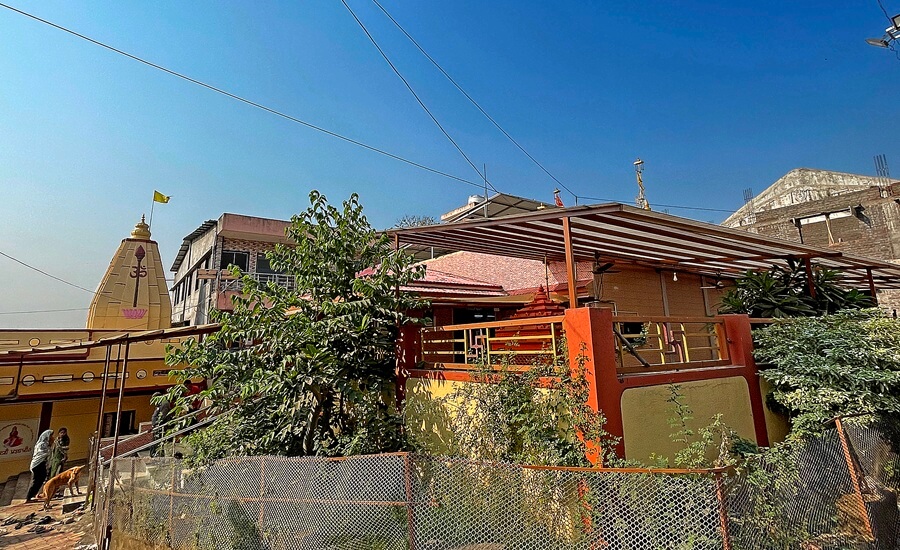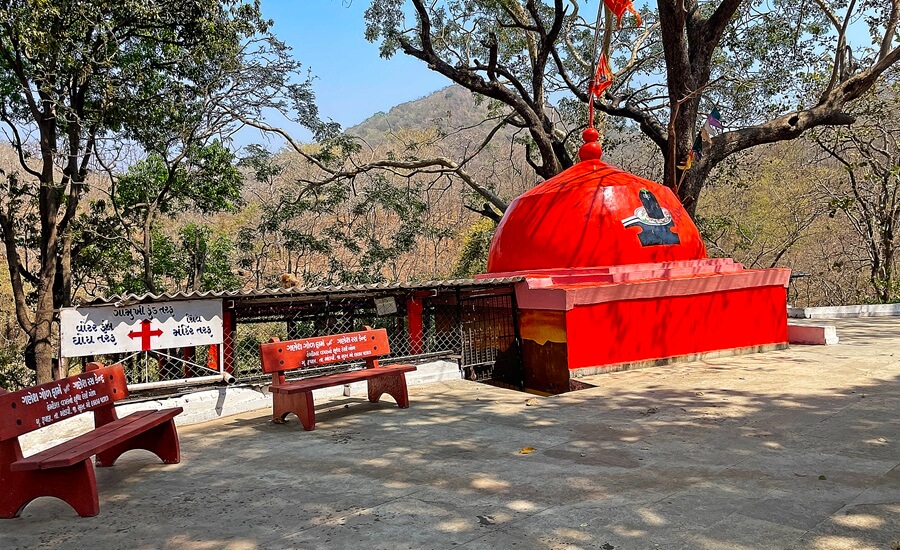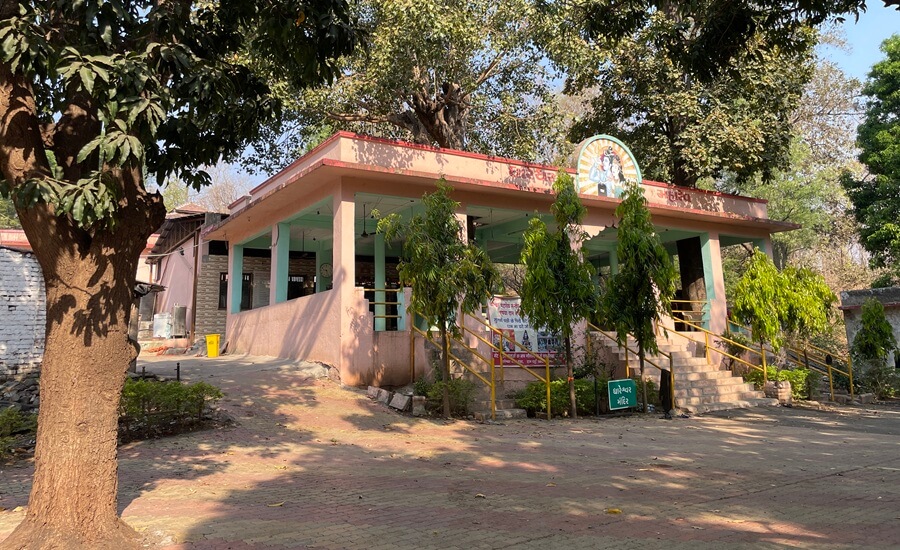
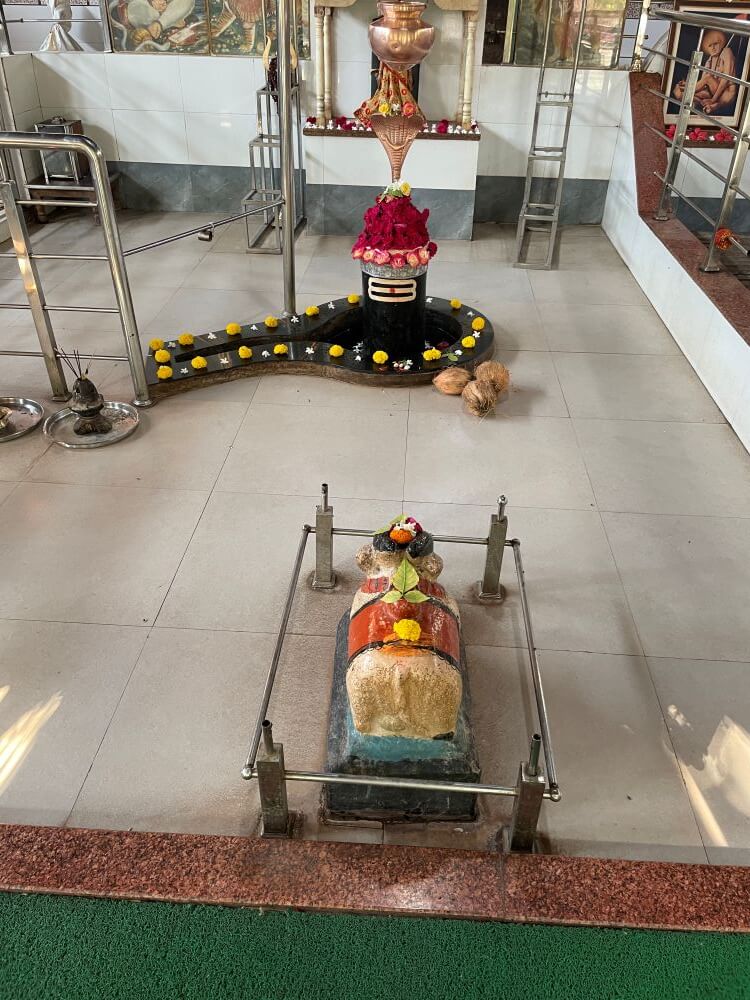
Situated in the dense forest of the Nesu East Range under the Vyara Forest Department in Gujarat, the Dhareshwar Mahadev Temple is located in the village of Gavan. According to the Tapi Purana , this Shivalinga was established by Dharmaraja (Yudhishthira). Devotees believe that because the part of Vishnu in this Shivalinga faces the north, this sacred place remains ever-vibrant. It is said that having heartfelt darshan (holy sight) of the Shivalinga here on Vaishakh Krishna Ashtami alleviates illnesses and wards off the fear of untimely death. A grand fair (yatra) dedicated to Dhareshwar is held during the month of Shravan (July–August). Devotees from both Gujarat and Maharashtra visit in large numbers.
In the 38th chapter of the Tapi Mahatmya Purana , there is a reference to this temple. A related legend states that Dharmaraja Yudhishthira performed the Asidhar Vrata (a particular form of penance) at this site. At that time, to test Dharmaraja’s devotion, Lord Bhairava appeared there in the guise of Duryodhana. Pretending to be ‘Duryodhana’, he said to Dharmaraja, “You are doing penance here with the intention of causing my death, but it will all be in vain.” He then began shouting loudly. Dharmaraja, however, remained extremely calm and inquired about his well-being. Acting as though he had not heard, ‘Duryodhana’ moved away. Some time later, the deceptive Duryodhana returned with the severed heads of the four Pandavas – Bhima, Arjuna, Nakula and Sahadeva – and presented them to Dharmaraja. Overwhelmed by grief, Dharmaraja drew his sword to cut off his own head.
Some time later, the deceptive Duryodhana returned with the severed heads of the four Pandavas – Bhima, Arjuna, Nakula and Sahadeva – and presented them to Dharmaraja. Overwhelmed by grief, Dharmaraja drew his sword to cut off his own head.
Moved by Dharmaraja’s brotherly love and unwavering devotion, Lord Shankara revealed himself. He explained to Dharmaraja that all of this was merely his illusion (maya). On realizing the divine play, Dharmaraja bowed to Lord Shankara and sought a boon, asking that he be able to ascend to heaven in his mortal body and that his body become as strong as a diamond (vajra). Granting his request, Lord Shankara declared, ‘Tathastu’ (So be it). Dharmaraja then requested Lord Shankara to reside permanently in that very place. 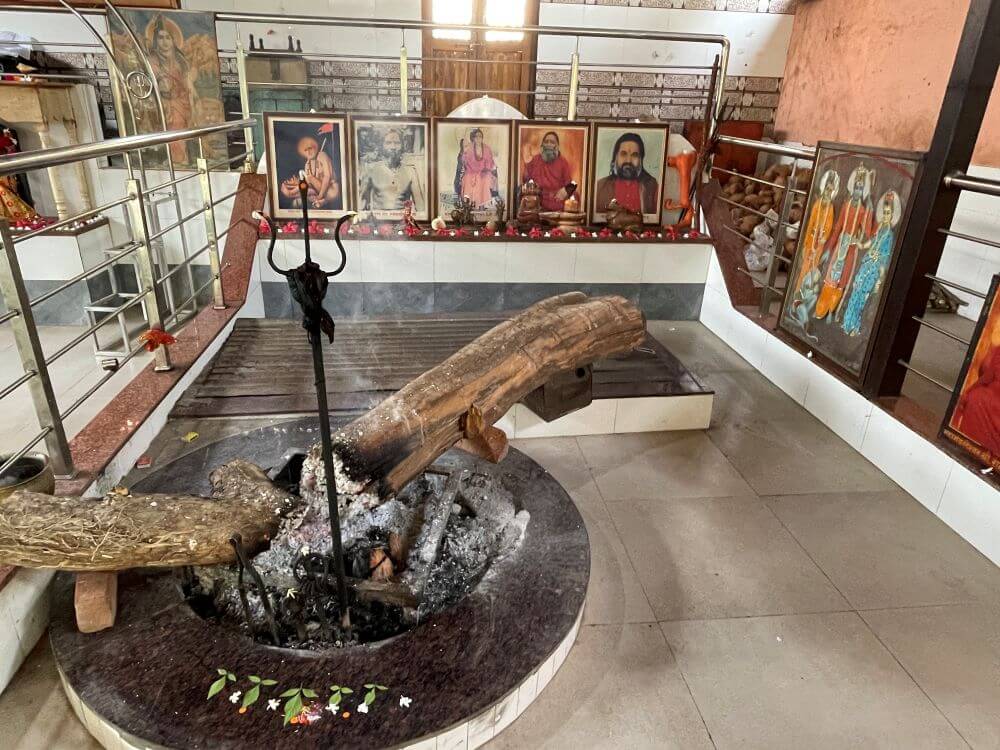 Accordingly, Lord Shankara manifested here as the Shivalinga called Dhareshwar. According to the Tapi Mahatmya Purana , the Pandavas took a holy bath at this Dhareshwar Tirtha on Vaishakh Krishna Ashtami.
Accordingly, Lord Shankara manifested here as the Shivalinga called Dhareshwar. According to the Tapi Mahatmya Purana , the Pandavas took a holy bath at this Dhareshwar Tirtha on Vaishakh Krishna Ashtami.
Over the centuries, the Shivalinga nestled in the dense forest eventually became buried underground. A few years ago, a wandering ascetic known as Vanvasi Baba, disciple of the saint from Maharashtra known as Khandvawala Dhunivale Baba, was engaged in deep penance in these woods. He had a divine vision of Lord Mahadev, who said, “I am near the riverbank.” Following this guidance, Vanvasi Baba, with the help of some local tribal people, carried out excavations in the area and discovered the Shivalinga. He initially installed it in his hut.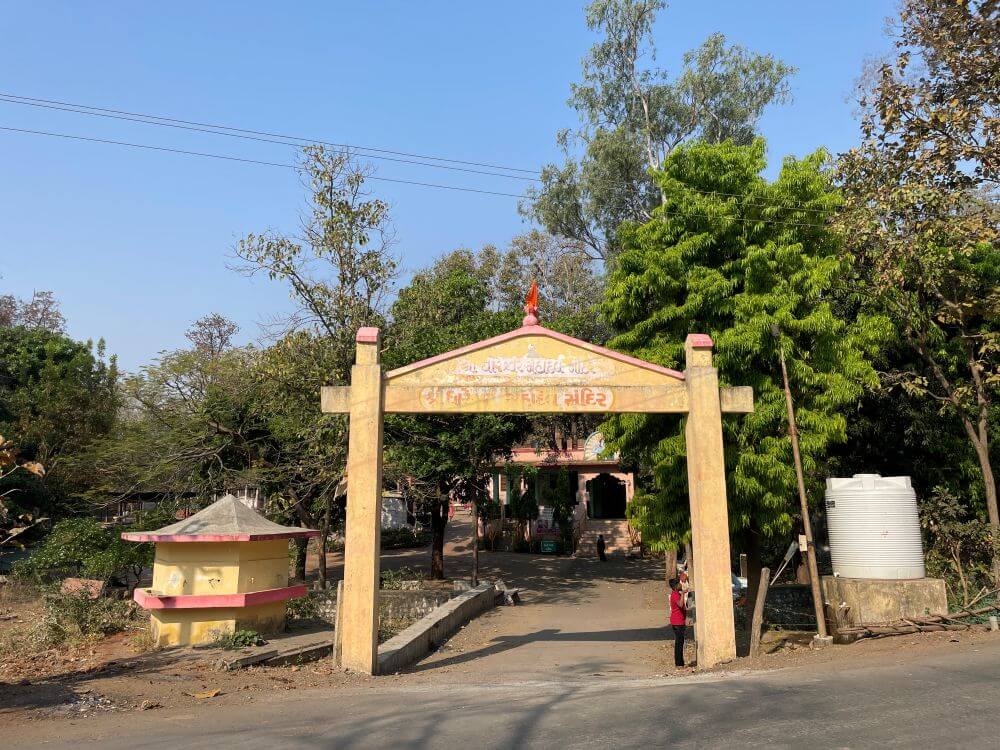 However, once the Ukai Dam was built on the Tapi River in 1972, the river waters began to reach the temple site. Consequently, Vanvasi Baba reinstalled the Shivalinga in a new hut at the current location. After a recent renovation, the temple took on the form in which it is now seen.
However, once the Ukai Dam was built on the Tapi River in 1972, the river waters began to reach the temple site. Consequently, Vanvasi Baba reinstalled the Shivalinga in a new hut at the current location. After a recent renovation, the temple took on the form in which it is now seen.
Positioned about one and a half kilometers inside the dense forest of the Nesu East Range under the Vyara Forest Department, close to the Uchchhal-Nizar State Highway, this temple is accessed by turning off the main road. A grand entrance archway stands at the temple premises. Within the courtyard, various types of trees flourish. Two of these trees harbor a large colony of bats, which can be seen flying even in broad daylight. Toward the left of the courtyard are play areas for children,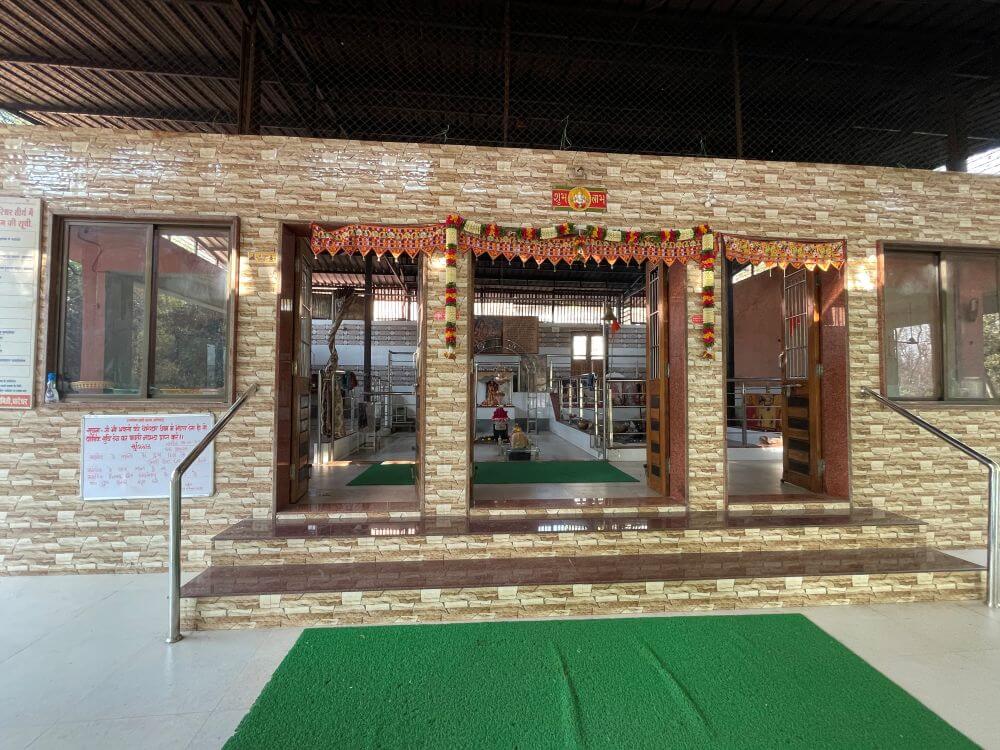 along with benches for devotees to sit. On the left side of the temple is an ancient, deep well.
along with benches for devotees to sit. On the left side of the temple is an ancient, deep well.
The Dhareshwar Mahadev Temple is of modern construction, built on a raised platform. Its design comprises a sabhamandap (main hall), an upsabhamandap (anteroom) and at the center, the garbhagriha (sanctum). Above the arched entranceway of the sabhamandap is a lovely painting of Shiva-Parvati at the center. This partially open sabhamandap has three entrances. One ascends a total of 11 steps from the main doorway to reach it. A unique feature of this sabhamandap is the presence of two trees whose branches extend up through the temple’s roof.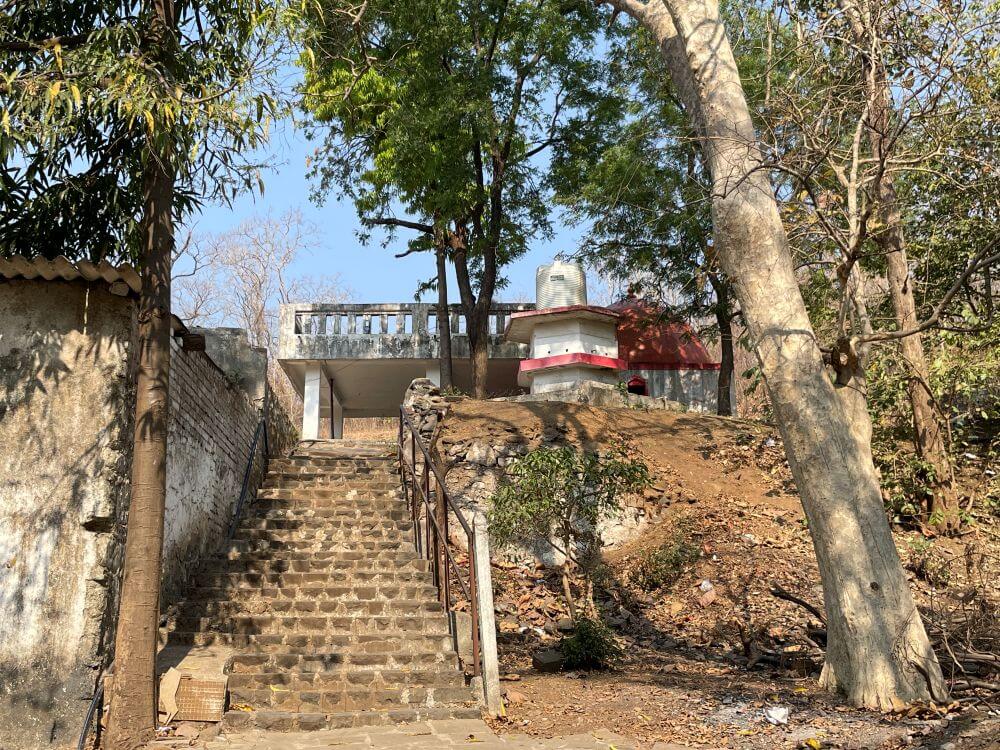 These two ancient trees – originally standing here – have been preserved. The tree on the right is home to many bats.
These two ancient trees – originally standing here – have been preserved. The tree on the right is home to many bats.
From here, one ascends two more long steps to enter the upsabhamandap (anteroom). Its outer walls are adorned with marble tiles. This anteroom has three entrances—one large and two smaller ones. The entire interior floor is laid with marble. On the right side, an eternal dhuni (sacred fire) burns continuously. In 1972, Vanvasi Baba brought this dhuni from his guru’s ashram, Khandvawala Dhunivala Baba in Maharashtra, walking 350 kilometers on foot. On a raised platform against the rear wall of the upsabhamandap are photographs of the revered saints : Vanvasi Baba himself, Swami Keshavanand Dadaji Dhunivale (from Khandwa), Janki Devi, Ramananddas Bapu and Ravinandandas Bapu. Also on display here is an ancient three-faced wooden idol of Lord Dattatreya. Notably, Datta is depicted seated cross-legged.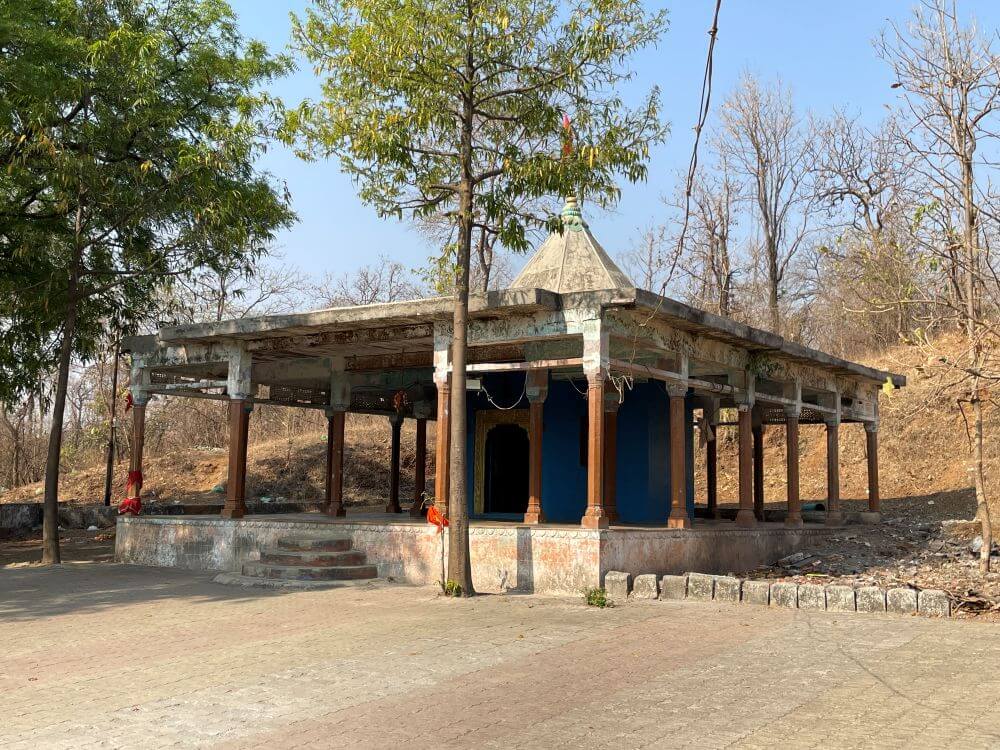 In front of this idol stand an ancient Shivalinga and a statue of Nandi.
In front of this idol stand an ancient Shivalinga and a statue of Nandi.
In the upsabhamandap, at a slightly lower level, lies the temple’s garbhagriha. A stainless-steel railing surrounds the platform area. Here, on a stone pedestal, stands a stone statue of Nandi. Directly in front of Nandi is a tortoise figure. Beyond that, on the floor, is the pind (Shivalinga) of Lord Dhareshwar Mahadev. A copper serpent hood is placed over this Shivalinga, shielding it like an umbrella. From the galantika (overhead water vessel) above, water drips continuously onto the Shivalinga as part of the ceremonial ablution (abhishek). The Shivalinga is invariably adorned with flowers. 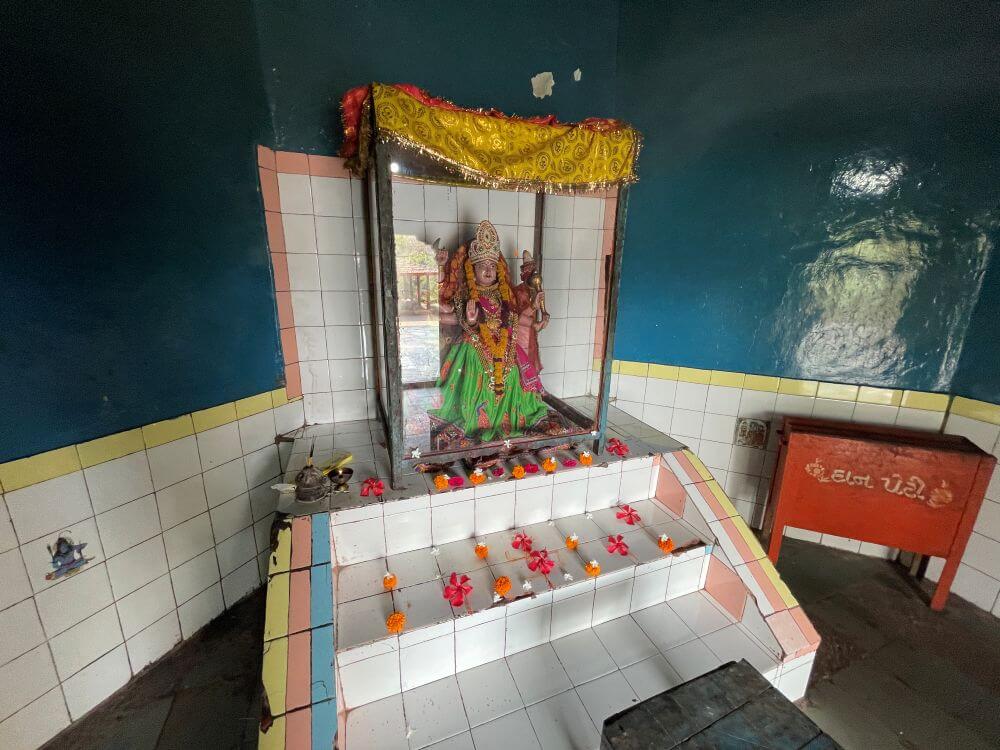 Behind the Shivalinga, on a marble altar, stands a graceful idol of Goddess Parvati in a decorated marble shrine.
Behind the Shivalinga, on a marble altar, stands a graceful idol of Goddess Parvati in a decorated marble shrine.
In a tin-roofed shed to the left of the temple, a daily Annachhatra (free meal service) is provided for devotees. There is also round-the-clock tea service available. Near this shed, steps have been built leading up a small hill near the temple. Behind the temple are smaller shrines dedicated to the Goddess Tapi (the river’s presiding deity), Mahadev and Hanuman. A homakund (fire pit for rituals) is housed in a nearby pavilion. A short distance away, to the right at the rear of the temple, stand the samadhi shrines of Saint Banwari Bapu, Ravinandandas Bapu and Janki Devi Mata.
Managed by the Tapovan Shanti Ashram, the temple is frequently visited by the local tribal community, who have deep faith in Lord Shiva here and come for regular darshan (worship). The temple organizes various religious programs throughout the year. There is a considerable turnout of devotees on Mahashivaratri and every Monday during the month of Shravan. A fair (yatra) is also held in Shravan. During this month, rituals such as Laghu Rudra, Maha Rudra, Ati Rudra and others are performed at the temple.
